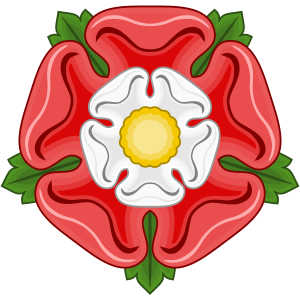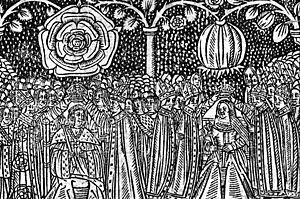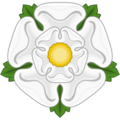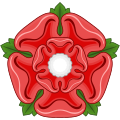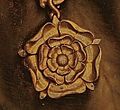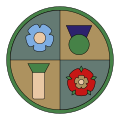Tudor rose facts for kids
The Tudor rose is a special flower symbol for England. It's also called the Union rose. This symbol comes from the Tudor family, who brought together two powerful families: the House of Lancaster and the House of York. The Tudor rose has five white petals inside, which stand for the House of York. It also has five red petals on the outside, which stand for the House of Lancaster.
Contents
How the Tudor Rose Began
The story of the Tudor rose starts with a big fight in England. This fight was later called the "Wars of the Roses". It was between the House of Lancaster, who used a red rose, and the House of York, who used a white rose.
In 1485, a battle called the Battle of Bosworth Field happened. Henry VII from the House of Lancaster won. He took the crown from Richard III of the House of York. This battle ended the long wars.
To bring peace, Henry VII married Elizabeth of York in 1486. She was from the House of York. This marriage helped to unite the two families. Henry VII then created the Tudor rose. It combined the white rose of York and the red rose of Lancaster. This new symbol showed that the two families were now together.
Some people say that the red rose of Lancaster wasn't used much before Henry VII. Kings from Lancaster sometimes used a rose, but it was often gold, not red. Henry VII made the red rose important to show he was a "peacemaker king."
The Tudor rose is often shown as a double rose. This means the white rose is on top of the red rose. It is always described as "proper," meaning it looks natural, even though this exact flower doesn't grow in nature.
Past Uses of the Tudor Rose
Henry VII didn't use the Tudor rose all the time. He often used just the Lancastrian rose. But his son, Henry VIII, used the Tudor rose more often. This was because Henry VIII was related to both the York and Lancaster families through his parents.
When Henry VIII's brother, Arthur, Prince of Wales, died in 1502, his tomb had both roses. This showed that he came from both the Lancaster and York families.
Henry VIII also had the famous "Round Table" at Winchester Castle repainted. He added a Tudor rose to the middle of it. His father, Henry VII, had built the Henry VII Chapel at Westminster Abbey. This chapel was decorated with the Tudor rose. This helped to show his strong claim to the throne.
The Tudor rose can also be shown "slipped and crowned." This means it looks like a cutting with a stem and leaves, with a crown on top. This symbol is seen in a famous painting of Elizabeth I. It has been the official flower symbol of England since 1800.
Sometimes, the Tudor rose was "dimidiated." This means it was cut in half and joined with half of another symbol. For example, Henry VIII and his first wife, Catherine of Aragon, used a symbol that joined the Tudor rose with Catherine's Spanish pomegranate. Their daughter, Mary I, used this same symbol.
When James VI of Scotland became King of England, he used a symbol that joined the Tudor rose with a Scottish thistle. This symbol also had a royal crown on top.
Modern Uses of the Tudor Rose
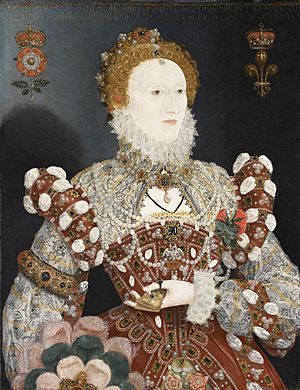
The crowned Tudor rose is still used as England's plant symbol. Scotland uses the thistle, Wales uses the leek, and Ireland uses the shamrock.
You can see the Tudor rose on the uniforms of the Yeomen Warders at the Tower of London. It was also on the 20-pence coin from 1982 to 2008. It is part of the royal coat of arms for the UK. It is also on the coat of arms of Canada.
The Tudor rose is part of the symbol for the Supreme Court of the United Kingdom. It stands for England, along with the symbols for Scotland, Wales, and Northern Ireland.
The Royal Navy's aircraft carrier, HMS Queen Elizabeth, uses a Tudor rose as its badge. The rose is divided vertically into red and white. The Tudor rose is also part of the cap badge for the Intelligence Corps in the British Army.
The Tudor rose is also the symbol for The Nautical Training Corps. This is a youth group in South East England. Their badge has the Tudor rose on an anchor.
Many towns and cities also use the Tudor rose. The town of Sutton Coldfield uses it often because Henry VIII gave it "Royal Town" status. The Tudor rose is on the coat of arms of Oxford. It is also the symbol for VisitEngland, which is England's tourist board.
In the United States, the borough of Queens in New York City uses a Tudor rose on its flag and seal. The flag of Annapolis, Maryland, has a Tudor rose and a thistle with a crown. The city of York, South Carolina is called "The White Rose City." The nearby city of Lancaster, South Carolina is called "The Red Rose City." York, Pennsylvania and Lancaster, Pennsylvania also use white and red roses as their symbols.
Images for kids
-
The white rose of the House of York
-
The red rose of the House of Lancaster
See also


